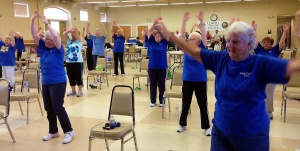Parkinson's Drugs Physiotherapy Implications
Introduction[edit | edit source]
The highly debilitating nature of Parkinson's Disease makes it imperative that the physical therapist (PT) understands the effects of the different drugs used in the treatment of Parkinson's and their interactions within the body. See Pharmacological Management of Parkinson’s
Effects of Parkinson’s Medications on Exercise Tolerance[edit | edit source]
As highlighted in the video below exercise is a critical part of treatment for Parkinson's and should be in done in the time slot that suits the clients "on" times. It may be appropriate for the client to keep a diary of symptoms. This may be helpful to track when symptoms occur so that your exercise sessions occur at the most effective timing.
A pre exercise subjective assessment should be undertaken to find if common side effects from the drugs may impact on treatment. The therapist needs to be be aware of possible side effects and monitor accordingly or/or adjust treatment. Adverse effects of each of these drug classes will require monitoring. A clear understanding of the general yellow flags to improper dosing is vital. These adverse effects result from the poly-pharmaceutical approach to PD management. Being aware of them allows us to alter our plan of care and not compromise the patient’s safety. If left unaddressed, these adverse effects could substantially decrease our overall quality of care that we administer.
- Orthostatic hypotension the link provides physiotherapy strategies used to manage this condition.
- Psychosis - report to specialist and curtail treatment.
- Gastrointestinal distress - postpone treatment
- Dyskinesias[2] - monitor carefully as a potential falls risk.
- Confusion/memory loss - instruct at appropriate level so they understand and follow commands.
- Psychological changes - report to specialist
- Sleepiness, fainting or dizziness - be vigilant on monitoring for such effects with exercise, again don't compromise the patients safety.
It may be that the person having side effects eg hallucinations and delusions or impulsive and compulsive behaviour, does not realise they are experiencing them.It’s important to report as the therapist you report this to the specialist as soon as you can.
The following drugs discussed will highlight the fundamental side effects of the prototypical drugs (an individual drug that represents a drug class ) used in the management of Parkinson’s disease and how this may impact physiotherapy.
Main Medications for Parkinson’s[edit | edit source]
The main types of drugs that are used to treat Parkinson’s are[3]:
Levodopa
Dopamine agonists
Glutamate antagonist
Anticholinergics
COMT inhibitors
MAO-B inhibitors
Levadopa[edit | edit source]
Side Effects[edit | edit source]
- "Wearing off’" (see text below)
- Dyskinesia
- Constipation
- Confusion
- Hallucinations and delusions
- Mood swings
- Psychological changes
- Sleepiness, fainting or dizziness
- Impulsive and compulsive behaviour, especially when given a combination with a dopamine agonist.
Wearing Off[edit | edit source]
Physical therapy treatment should be administered during the peak effective time of each individual medication; or ideal treatment effects may be compromised due to a negative event known as End of Dose Dyskinesia. ie check the timing of physiotherapy sessions with the client so they will benefit maximally from there exercises. The video below outlines this phenomena
This occurrence involves the positive anti-spasmodic effects of the drug tapering off before the next dose can be administered. When Parkinson’s medication is working well, Parkinson’s symptoms will be well-controlled. This is called ‘on’ time. When symptoms are not well-controlled or are not responding to medication, this is called being ‘off’. As Parkinson’s progresses, some people find that a dose lasts a shorter time duration. This is called ‘wearing off’. Symptoms will include more noticeable tremor, stiffness, feeling tired, low mood, sweating and anxiety. This can happen quickly and there will be a sudden change between being ‘on’ and ‘off'- obviously not a good time to exercise.
Dopamine Agonists[edit | edit source]
Side Effects[edit | edit source]
- Nausea and vomiting
- Constipation
- Headaches
- Drowsiness and sudden ‘attacks’ of sleepiness
- Orthostatic hypotension
- Hallucinations or delusions and confusion
- Impulsive or compulsive behaviours.
- Existing dyskinesias (involuntary movements) becoming more troublesome initially
Glutamate Antagonists[edit | edit source]
Side Effects
- Blurred vision, fainting, confusion or dizziness
- Swelling of the ankles or a mottled appearance on the skin of the lower leg
Anticholinergics[edit | edit source]
- Constipation
- Blurred vision
- Increased risk of memory loss and, in men, problems urinating.
COMT Inhibitors[edit | edit source]
- Increase the side effects caused by levodopa, notably dyskinesias, nausea and vomiting.
- Diarrhoea which may occur some months after commencing the medication.
- Orthostatic hypotension
MAO-B Inhibitors[edit | edit source]
When selegiline is taken together with levodopa, side effects include dyskinesias, hallunications or vivid dreaming.
When people have taken rasagiline on its own (without levodopa), the most commonly reported side effects have been:
- Headache
- Aching joints
- Indigestion
- Flu-like symptoms
- Depression
- When taken with levodopa, the most common reports have been of uncontrolled movements and accidental falls.
Conclusion[edit | edit source]
Exercise is essential in the management of Parkinsons. However, clients with Parkinsons are most likely taking medications that can possibly have an effect on their physical response and tolerance to exercise. Therefore physiotherapists need to be aware of potential side effects and then time, dose and monitor exercise accordingly. The above hopefully gives you guidance on the best way to monitor and administer your exercise sessions
Reference:
- ↑ LivingHealthyChicago Exercise and Parkinsons disease Available from: https://www.youtube.com/watch?v=ikY9WpmekRY&app=desktop (last accessed 7.11.2019)
- ↑ Connolly BS, Lang AE. Pharmacological Treatment of Parkinson Disease. Jama. 2014;311(16):1670. doi:10.1001/jama.2014.3654.
- ↑ Parkinsons Victoria Medications Available from: https://www.parkinsonsvic.org.au/parkinsons-and-you/medications/ (last accessed 7.11.2019)
- ↑ BG Causes and symptoms of wearing off in PD patients Available from: https://www.youtube.com/watch?v=-9znpl9Svrg (last accessed 7.11.2019)







